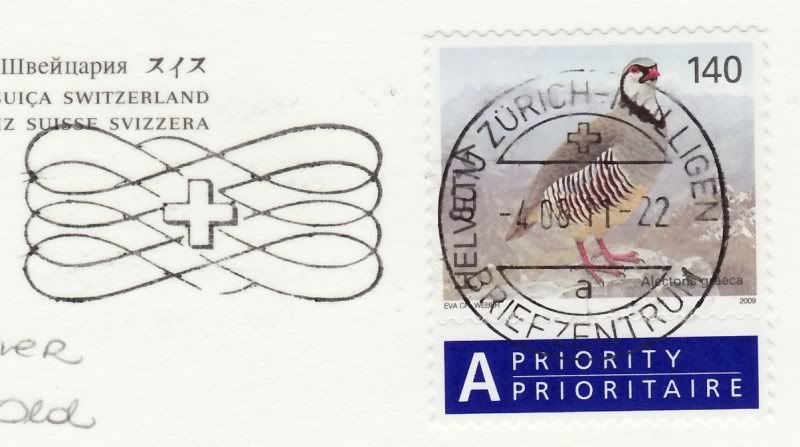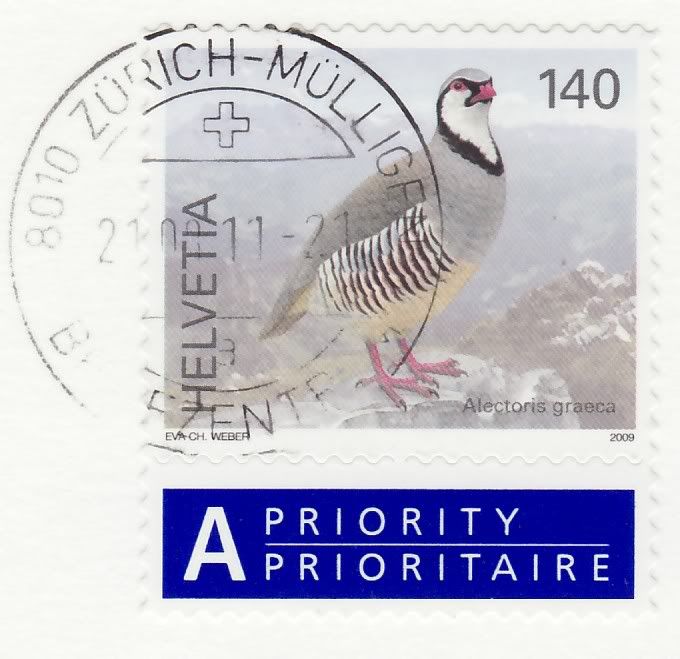Stamp issued on 8 May 2009.
The Rock Partridge, Alectoris graeca, is a gamebird in the pheasant family Phasianidae of the order Galliformes, gallinaceous birds.
This partridge has its main (native) range in southwestern Asia and southeastern Europe, and is closely related and very similar to its eastern equivalent, the Chukar Partridge, A. chukar.
This is a resident breeder in dry, open and often hilly country. It nests in a scantily lined ground scrape laying 5-21 eggs. The Rock Partridge takes a wide variety of seeds and some insect food.
The Rock Partridge is a rotund bird, with a light brown back, grey breast and buff belly. The face is white with a black gorget. It has rufous-streaked flanks and red legs. When disturbed, it prefers to run rather than fly, but if necessary it flies a short distance on rounded wings.
It is very similar to the Chukar Partridge, but is greyer on the back and has a white, not yellowish foreneck. The sharply defined gorget distinguishes this species from Red-legged Partridge. The song is a noisy ga-ga-ga-ga-chakera- chakera- chakera.
 This species is declining in parts of its range due to habitat loss
and over-hunting. While it generally manages to hold its own, the status
of the Sicilian population may be more precarious and certainly deserves attention (Randi 2006).
This species is declining in parts of its range due to habitat loss
and over-hunting. While it generally manages to hold its own, the status
of the Sicilian population may be more precarious and certainly deserves attention (Randi 2006).
The Rock Partridge, Alectoris graeca, is a gamebird in the pheasant family Phasianidae of the order Galliformes, gallinaceous birds.
This partridge has its main (native) range in southwestern Asia and southeastern Europe, and is closely related and very similar to its eastern equivalent, the Chukar Partridge, A. chukar.
This is a resident breeder in dry, open and often hilly country. It nests in a scantily lined ground scrape laying 5-21 eggs. The Rock Partridge takes a wide variety of seeds and some insect food.
The Rock Partridge is a rotund bird, with a light brown back, grey breast and buff belly. The face is white with a black gorget. It has rufous-streaked flanks and red legs. When disturbed, it prefers to run rather than fly, but if necessary it flies a short distance on rounded wings.
It is very similar to the Chukar Partridge, but is greyer on the back and has a white, not yellowish foreneck. The sharply defined gorget distinguishes this species from Red-legged Partridge. The song is a noisy ga-ga-ga-ga-chakera- chakera- chakera.
 This species is declining in parts of its range due to habitat loss
and over-hunting. While it generally manages to hold its own, the status
of the Sicilian population may be more precarious and certainly deserves attention (Randi 2006).
This species is declining in parts of its range due to habitat loss
and over-hunting. While it generally manages to hold its own, the status
of the Sicilian population may be more precarious and certainly deserves attention (Randi 2006).
No comments:
Post a Comment